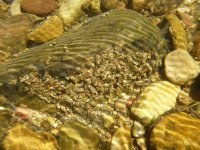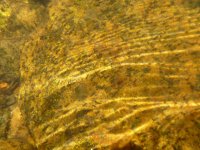NJpatbee
Can be found on NJ/NY/PA waters!
Like most of us, I have planned days off, traveled hundreds of miles, and risked domestic harmony to catch Mayfly hatches during their peak emergence periods throughout the Northeast. For myself, Quill Gordons, Hendricksons, Blue Quills, March Browns, Green Drakes, Light Cahills, Blue Winged Olives, White Flies, along with others, conjure up images of dry fly fishing heaven. However, the trout dry fly fishing season is a long one, and there are more times when the mayflies are not hatching when I am on the water. Some also bemoan the empty times, such as the period between the Hendricksons and Sulphurs in the Spring.
A couple of books, read early in my fly fishing days, allowed me to avoid the dependence on mayfly hatches for dry fly fishing that many have inherited. Many of you have read Vince Marinaro's Modern Dry Fly Code from the early 1950's, which did a great job of convincing me to tie and fish terrestrials, especially in the Summer. The second book, Leonard Wright's Fishing the Dry Fly as a Living Insect published early in the 1970's, gave us a type of pattern (Fluttering Caddis) and a method of fishing it that opened up a whole new world to me. I started with a couple of shades (tan/brown, black/grey) in a couple of sizes and using Wright's down and across method I caught trout on the top from Spring through Fall. Taking it one step futher, a good caddis reference book such as The Caddisfly Handbook: An Orvis Streamside Guide gives a concise description of the major Caddis hatches in the Western and Eastern US. I now tie eight different caddis patterns and have a good idea of when and where to find them. I have modified Wright's original pattern to my own liking, but the basic pattern type is the same.
Each of these books can still be found, and Wright's book was re-published in soft cover in 1988. If you enjoy action on the top, I recommend that you take the Caddis Fly more seriously and do some investigation. The "empty times" will be far fewer.
A couple of books, read early in my fly fishing days, allowed me to avoid the dependence on mayfly hatches for dry fly fishing that many have inherited. Many of you have read Vince Marinaro's Modern Dry Fly Code from the early 1950's, which did a great job of convincing me to tie and fish terrestrials, especially in the Summer. The second book, Leonard Wright's Fishing the Dry Fly as a Living Insect published early in the 1970's, gave us a type of pattern (Fluttering Caddis) and a method of fishing it that opened up a whole new world to me. I started with a couple of shades (tan/brown, black/grey) in a couple of sizes and using Wright's down and across method I caught trout on the top from Spring through Fall. Taking it one step futher, a good caddis reference book such as The Caddisfly Handbook: An Orvis Streamside Guide gives a concise description of the major Caddis hatches in the Western and Eastern US. I now tie eight different caddis patterns and have a good idea of when and where to find them. I have modified Wright's original pattern to my own liking, but the basic pattern type is the same.
Each of these books can still be found, and Wright's book was re-published in soft cover in 1988. If you enjoy action on the top, I recommend that you take the Caddis Fly more seriously and do some investigation. The "empty times" will be far fewer.



